
Grapple of SpaceX CRS-5 at the International Space Station, 5:54 am EST, Monday, January 12, 2015. Credit: NASA
A Window on SSEP Spaceflight Operations
The SpaceX Dragon spacecraft carrying the Yankee Clipper II payload of Mission 6 experiments was captured by Canadarm2 at the International Space Station (ISS) at 5:54 am EST, Monday, January 12, 2015. Dragon berthed at the Station at 8:56 am EST.
Yankee Clipper II was transferred to ISS, and astronaut and ISS Commander Barry Wilmore activated 5 of 17 SSEP Mission 6 experiments on schedule on Tuesday, January 13, 2015. These activations were pre-planned activities defined by the student flight teams for day of Arrival at ISS (designated A=0).
Station Commander Wilmore activated the experiments at 8:00 am EST. Details of the activations on orbit were then communicated to Earth, to Marshall Space Flight Center, and then in turn to Johnson Space Center and to our launch services provider NanoRacks. NanoRacks then informed the National Center for Earth and Space Science Education at 8:28 am EST, just 30 minutes after on-orbit activation. The Center then formally recorded the activity on the SSEP Mission 6 to ISS; Experiment Log page.
This communications pathway is critical for experiment success. The student flight teams are using the information provided on the Log page to carry out concurrent ground truth experiments. Conducting identical experiments on the ground is critical. Once the flight experiment (operating in the apparent absence of gravity) is returned to Earth, an analytical comparison with the ground experiment (operating in the presence of gravity) allows the role of gravity to be assessed for the physical, chemical, or biological system under study.
There are 5 scheduled Crew Interaction Days with Yankee Clipper II: Arrival day (A=0); Arrival plus 2 days (A+2); Undock minus 14 days (U-14); Undock minus 5 days (U-5); and Undock minus 2 days (U-2). The schedule of available Crew Interaction Days for SSEP is one of many real spaceflight operational constraints that all student teams must take into account when designing and proposing SSEP experiments. Click on the graphic at right to see the Crew Interaction Schedule for Yankee Clipper II, which was integrated into the overall ISS crew schedule by Marshall Space Flight Center and NanoRacks months before launch as part of lock-down of the flight configuration for all SSEP experiments.
At 1:15 pm EST, Thursday, January 15, 2015, Commander Wilmore carried out the scheduled A+2 activation of 2 more Yankee Clipper II experiments, and de=activation of 3 experiments that were activated 2 days earlier.
Video of Dragon berthing at ISS
To provide a sense of the formal communications for Yankee Clipper II experiment activity, below is the first NanoRacks communique received by the National Center for Earth and Space Science Education at 8:28 am EST, January 13, providing the details of the on-orbit activities:
NanoRacks Communique
NanoRacks Module 9 S/N 1015 and 1016 Payload Science Status Report
Increment: 41
Mission Day: GMT 013
Originator: Rob Alexander
Date: January 13, 2014
Science Status: ISS Commander Barry Wilmore performed the following NanoRacks Mixture Tubes interactions on orbit today. The interaction begain at 12:58 GMT (0658 CST). Video downlink was viewed on Downlink 1.
The following experiments were activated:
S/N 1015, Tube 7: Reishi Mushroom VS. E.coli and Chronic Myeloid Leukemia
S/N 1016, Tube 6: Composting in Microgravity
S/N 1016, Tube 7: Attachment of Escherichia Coli K-12 strand to Lettuce
S/N 1016, Tube 8: How Microgravity affects Yeast Cell Division and How it Relates to Human Cancer Cells
S/N 1016, Tube 9: Crystal Tetras
Unexpected Events: N/A
Science Look Ahead: The next mix tube operations will be in two days, on GMT 015.
The following experiments will be activated:
S/N 1015, Tube 3: Creating Crystals in Space
S/N 1015, Tube 6: Effects of Microgravity on Early Musca domestica Growth
The following experiments will be deactivated:
S/N 1015, Tube 7: Reishi Mushroom VS. E.coli and Chronic Myeloid Leukemia
S/N 1016, Tube 8: How Microgravity affects Yeast Cell Division and How it Relates to Human Cancer Cells
S/N 1016, Tube 9: Crystal Tetras
Topics for resolution: N/A
The Student Spaceflight Experiments Program (SSEP) is a program of the National Center for Earth and Space Science Education (NCESSE) in the U.S., and the Arthur C. Clarke Institute for Space Education internationally. It is enabled through a strategic partnership with NanoRacks LLC, working with NASA under a Space Act Agreement as part of the utilization of the International Space Station as a National Laboratory. SSEP is the first pre-college STEM education program that is both a U.S. national initiative and implemented as an on-orbit commercial space venture.
The Smithsonian National Air and Space Museum, Center for the Advancement of Science in Space (CASIS), and Subaru of America, Inc., are National Partners on the Student Spaceflight Experiments Program.


Comments are closed.